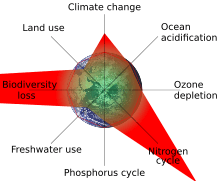Latvian Green Party
Latvian Green Party Latvijas Zaļā partija | |
|---|---|
|
| |
| Leader |
Raimonds Vējonis, Viesturs Silenieks |
| Founded | 13 January 1990 |
| Headquarters | Riga |
| Ideology |
Green politics[1] Green conservatism |
| Political position | Centre[1] |
| National affiliation | Union of Greens and Farmers |
| European affiliation | European Green Party |
| International affiliation | Global Greens |
| European Parliament group | No MEPs |
| Colours | Green |
| Saeima |
6 / 100 |
| European Parliament |
0 / 8 |
| Website | |
| zp.lv | |
| Part of a series on |
| Green politics |
|---|
.svg.png) |
|
Core topics |
|
Four Pillars |
|
The Latvian Green Party (Latvian: Latvijas Zaļā partija, LZP) is a green political party in Latvia.[1] It was founded on 13 January 1990 and is a member of the European Green Party. Unusually for a Green party in Europe, the LZP has always been considered a centre-right party.[2][3] Leading politicians of the party have often shown reactionary, nationalist, and homophobic values.[4] The party has only gained representation in the Saeima by forming electoral alliances with other parties.
History
The Supreme Council of the Republic of Latvia elected in 1990 contained seven Green delegates. After the Constitution of Latvia was restored, the election of the 5th Saeima (1993-1995) returned one Green deputy, Anna Seile, on the list of the right-wing Latvian National Independence Movement. In the 6th Saeima (1995-1998), there were four members: Indulis Emsis, Guntis Enins, Janis Kalvins and Janis Razna.
From 1993 until 1998, the Greens were part of the governing coalition with Indulis Emsis as Minister of State for Environmental Protection. The party lost its representation in the election to the 7th Saeima (1998–2002).
For the 2002 parliamentary election, the party formed the Union of Greens and Farmers (ZZS) coalition with the Latvian Farmers' Union. Three members of the Green party were elected: Indulis Emsis, Arvids Ulme and Leopolds Ozolins. The ZZS joined a four-party center-right coalition government and was represented with three ministers, one of them from the Green party, Minister for the Environment Raimonds Vejonis.
In February 2004, after the breakdown of the four-party government, Indulis Emsis was appointed to form a new government and became the first head of government of a country anywhere in the world from a Green party.[5] His minority government was forced to resign in December of the same year. A new coalition government led by the People’s Party took office, in which the party was again represented as part of the ZZS.
For the 2006 parliamentary election, the party remained part of the ZZS, and won four seats. The party remained part of the centre-right coalition government along with the People’s Party, Latvia's First Party/Latvian Way, and the Nationalist For Fatherland and Freedom. Party chairman and former prime minister Indulis Emsis became Speaker of the Saeima from November 2006 until September 2007.
Election results
Parliament (Saeima)
| Election year | # of overall votes |
% of overall vote |
# of overall seats won |
+/– | Notes |
|---|---|---|---|---|---|
| 1993 | 149,347 | 13.4 | 1 / 100 |
[lower-alpha 1] | |
| 1995 | 60,352 | 6.3 | 4 / 100 |
|
[lower-alpha 2] |
| 1998 | 22,018 | 2.3 | 0 / 100 |
|
[lower-alpha 3] |
| 2002 | 93,759 | 9.5 | 3 / 100 |
|
[lower-alpha 4] |
| 2006 | 151,595 | 16.8 | 4 / 100 |
|
[lower-alpha 5] |
| 2010 | 190,025 | 20.1 | 4 / 100 |
|
[lower-alpha 6] |
| 2011 | 111,955 | 12.2 | 4 / 100 |
|
[lower-alpha 7] |
| 2014 | 178,210 | 19.5 | 6 / 100 |
|
[lower-alpha 8] |
- ↑ The LNNK list won 15 seats - 1 went to the Green Party
- ↑ Joint Green Party-National Conservative Party list won 8 seats.
- ↑ Joint list of Green Party-Workers' Party-Christian Democratic Union
- ↑ Union of Greens and Farmers list won 12 seats
- ↑ Union of Greens and Farmers list won 18 seats
- ↑ Union of Greens and Farmers list won 22 seats
- ↑ Union of Greens and Farmers list won 13 seats
- ↑ Union of Greens and Farmers list won 21 seats
Chairpersons
Three co-chairpersons share the leadership position at any one time. Former chairpersons of the Latvian Green Party include:
- Olegs Batarevskis (1990–1997)
- Valts Vilnitis (1990–1991)
- Juris Zvirgzds (1990–1995)
- Gunars Lakutis (1991–1993)
- Peteris Jansons (1993–1994)
- Janis Kalvins (1994–1995)
- Indulis Emsis (from 1995)
- Ruta Bendere (1995–1996)
- Askolds Klavins (1996–2001)
- Valdis Felsbergs (1997–2003)
- Viesturs Silenieks (from 2001)
- Raimonds Vējonis (from 2003)
As of 2011, chairpersons are Viesturs Silenieks and Raimonds Vējonis.
See also
References
- 1 2 3 "Parties and Elections in Europe, "Latvia", The database about parliamentary elections and political parties in Europe, by Wolfram Nordsieck". Parties & Elections. 19 March 2013. Retrieved 19 March 2013.
- ↑ FIBS Report: Central Eurasia, 1993, p. 107.
- ↑ Marja Nissinen: Latvia's Transition to a Market Economy: Political Determinants of Economic Reform Policy, London: Palgrave Macmillan 1998, p. 119.
- ↑ Emilie van Haute: Green Parties in Europe, London: Routledge 2016, p. 119.
- ↑ Emilie van Haute: Green Parties in Europe, London: Routledge 2016, p. 118.
